Dr. Phil Zeltzman’s Blog
What Is Quality of Life For a Pet?
I frequently have difficult conversations with pet owners that revolve around quality of life.
Most recent examples include:
. Is it ethical to perform ACL surgery in a pet with cancer?
. Is it reasonable to perform surgery in a 13 year old dog with laryngeal paralysis (ie who suffocates around the clock)?
. Is it fair to amputate a pet who has non-operable cancer on a leg?
It certainly depends on the situation, but overall the answer is YES – for the right pet and the right pet owner.
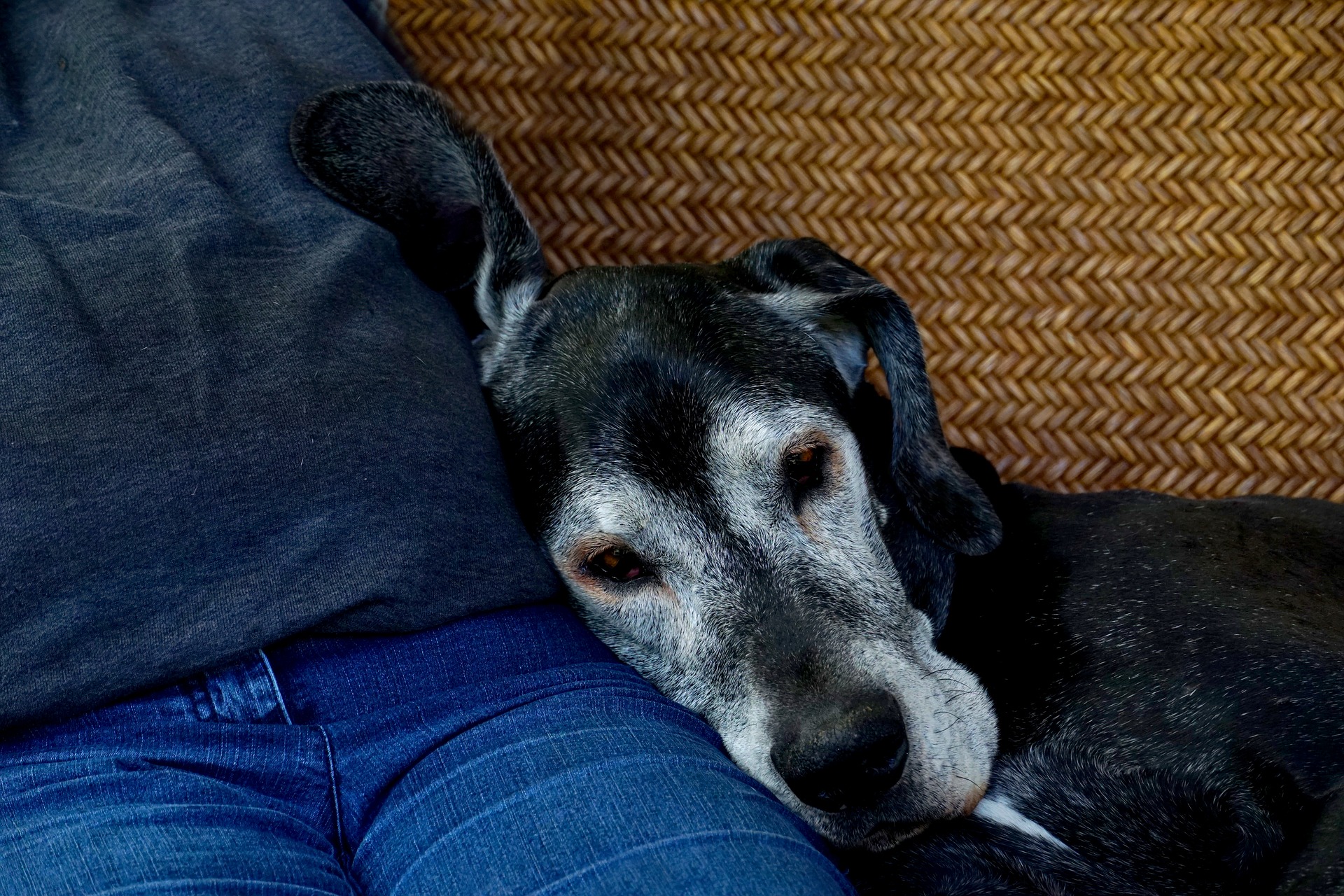
Pets don’t need a vacation home, stock options or designer clothes.
What they do need is being able to eat, drink, breathe, walk, urinate, defecate, groom and sleep – all in a pain free manner. And hopefully, you can expect a little tail wag here and there from a dog and a happy meow from a cat.
This list is certainly debatable, I admit it. One could add that a pet should be free of loneliness, fear and boredom. But I think the short list is a good starting point when you consider medical conditions.
If any of these basic bodily functions doesn’t take place, or if it occurs with difficulty, discomfort or pain, then your pet has a decreased quality of life.
What can you do then? You need to start by having a serious conversation with your family veterinarian. Or a board-certified surgeon.
Questions that need to be answered are:
. Is my pet suffering?
. Why is my pet painful?
. How can we decrease the pain?
. Can medications help?
. Can surgery help?
Of course, you may not hear the real story, the truthful story, because some people may not be bold or upfront enough to tell you what you need to hear.
I regularly talk to clients whose cat has been beyond constipated for YEARS before they got help (surgery is the only realistic solution).
I regularly talk to clients whose dog has been struggling to breathe for months or even years before they sought help (surgery is the only realistic solution).
I regularly talk to clients who had been told that a skin mass is not a big deal, or that a mass cannot be removed… when it truly is a big deal, and it absolutely can and should be removed.
Of course, surgery is not always the only option, I’m much more objective than that!
If your dog limps, pain medications, surgery, joint supplements, weight-loss or a “joint food” might help.
If your pet has a hormone imbalance, medications may solve the problem. The list goes on…
How can you tell if your pet’s quality of life is changing?
One subjective but simple way is to use a scale from 1 to 10, 1 being the poorest quality of life and 10 being the best. If you rate your pet as a 9 in January and a 2 in May, then it is time to face the evidence. It’s time to have a heart-to-heart discussion with your family and your veterinarian about what can realistically be done.
If you are starting to wonder about your pet’s quality of life, here is my suggestion: print a few copies of the “HHHHHMM” Quality of Life scale. Then fill in one table regularly – monthly, weekly or even daily depending on the situation.
This will help you see a trend more objectively: is your pet’s status the same, better, or worse than last time you assessed the situation?
Remember this very important concept: “age is not a disease.” Just because a pet is 12 or 14 or 16 years old does not mean you should give up easily. That said, if neither pain management nor medical and surgical treatments can help, then maybe it is time to consider euthanasia.
As emotionally and ethically difficult as it is for a pet owner, the whole family, and the veterinarian and his/her staff, euthanasia is sometimes the only reasonable, humane solution. It may be the only way your pet finds relief.
Quality of life includes your pet’s right to stop suffering with dignity once all reasonable options have been exhausted.
Phil Zeltzman, DVM, DACVS, CVJ, Fear Free Certified

Dr. Phil Zeltzman is a traveling veterinary surgeon in Pennsylvania & New Jersey. An award-winning author, he loves to share his adventures in practice along with information about vet medicine and surgery that can really help your pets. Dr. Zeltzman specializes in orthopedic, neurologic, cancer, and soft tissue surgeries for dogs, cats, and small exotics. By working with local family vets, he offers the best surgical care, safest anesthesia, and utmost pain management to all his patients. Sign up to get an email when he updates his blog, and follow him on Facebook, too!
Nino’s open chest surgery reveals a shocking finding
Nino, a sweet 11 year old pit bull, had recently developed a cough.
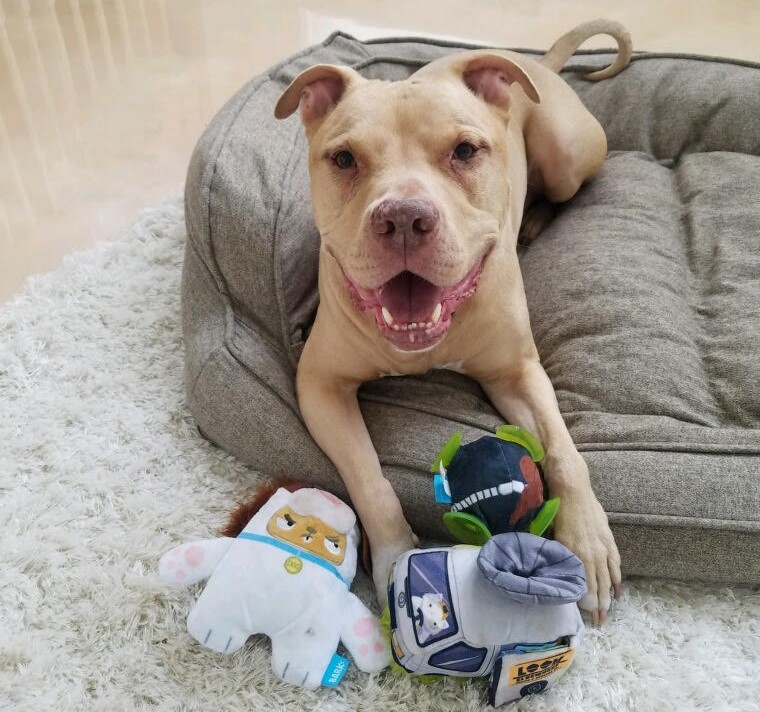
Initially, he was coughing from time to time. Then the coughing became more frequent. His owner took him in to see his family vet. Chest X-rays revealed a shocking finding. Nino had a mass in his left lung. Statistically speaking, this was very likely to be cancer.
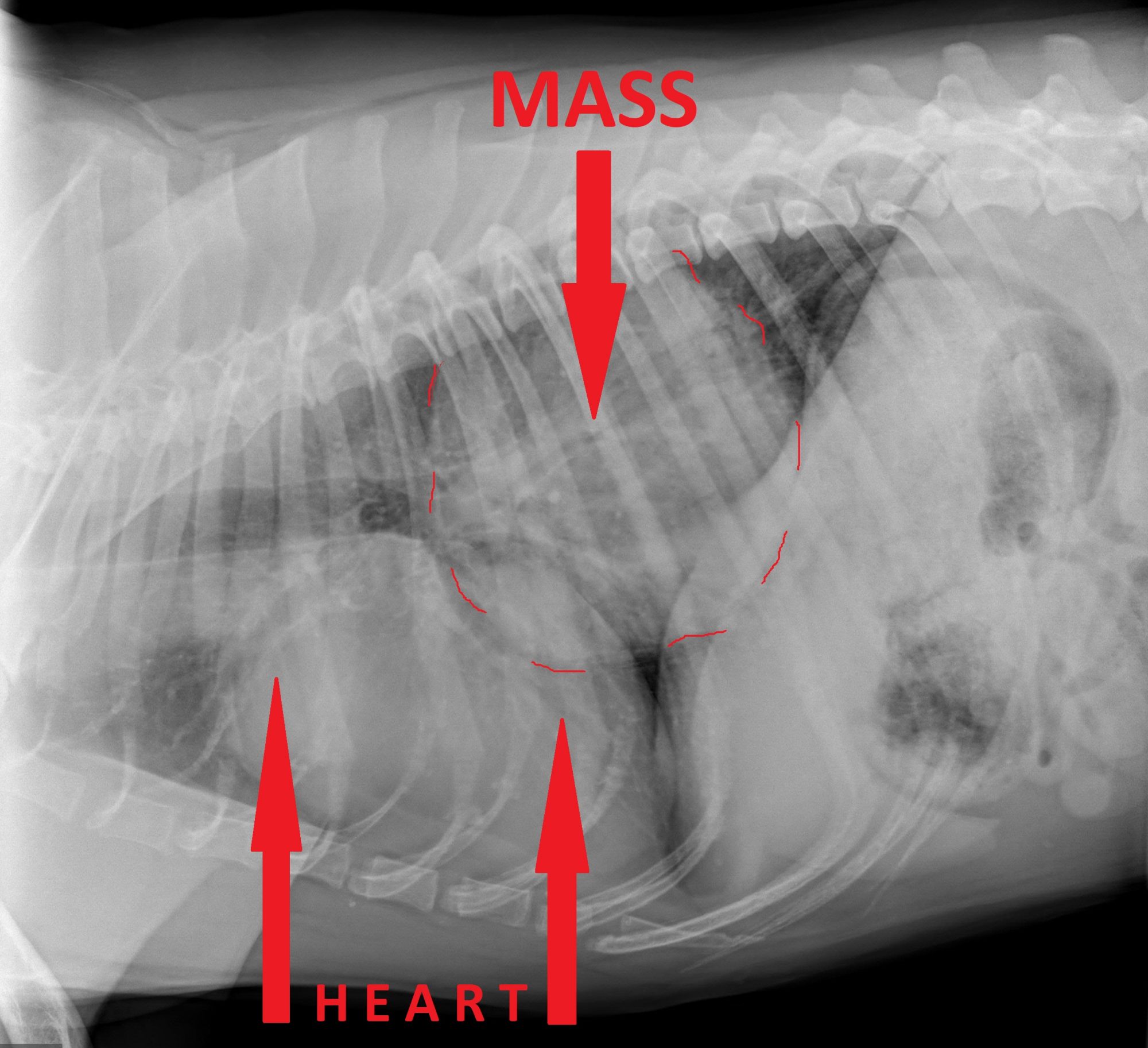
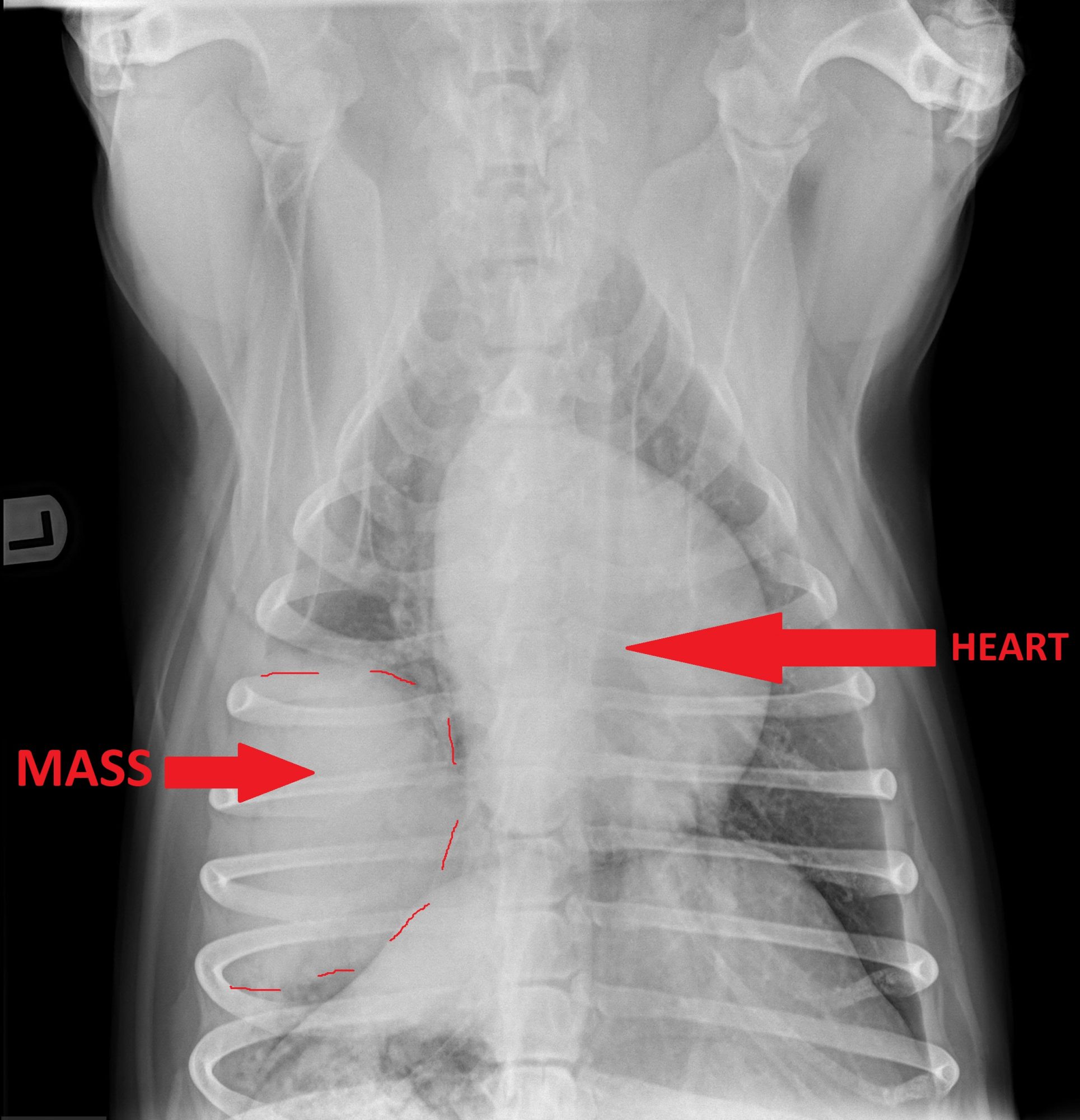
The X-rays above show the heart and the mass (with a broken line around it to show it better).
Nino’s owner says: “We were in disbelief and shock. He has always been a very active dog.”
The vet recommended an ultrasound of the chest to collect more information regarding the mass. According to the ultrasound, it measured about 8 by 9 cm (3 by 4 inches), so roughly about the size of your fist.
The client continues: “We immediately left in search of a surgeon’s opinion as we knew this would be a dangerous and heavy procedure.”
“By searching for recommended pet surgeons in Pennsylvania, we found your name and website, along with previous stories and reviews.”
Nino’s owner reached out to me to discuss surgery (lung lobectomy). Could this mass be removed?
Nino’s owner said: “After several consultations with you, we were hopeful but never more terrified. The level of risk explained was almost too much to handle for any loving pet parent. There was no choice other than to perform the surgery. You get a small sense of hope when you know you’re doing the only thing possible to help him. But the doom and gloom prevail. We dreaded the surgery date until it finally came.”
We worked quickly to get Nino’s surgery on our schedule.
FAIR WARNING: THE FOLLOWING PICTURES ARE GRAPHIC.
Once we got into surgery, there was one tiny little problem: the mass was much larger than the ultrasound suggested!
It was about 15 cm (or 6 inches) in diameter, or about the size of a large grapefruit!
REMINDER: THE FOLLOWING PICTURES ARE NOT FOR THE FAINT OF HEART.
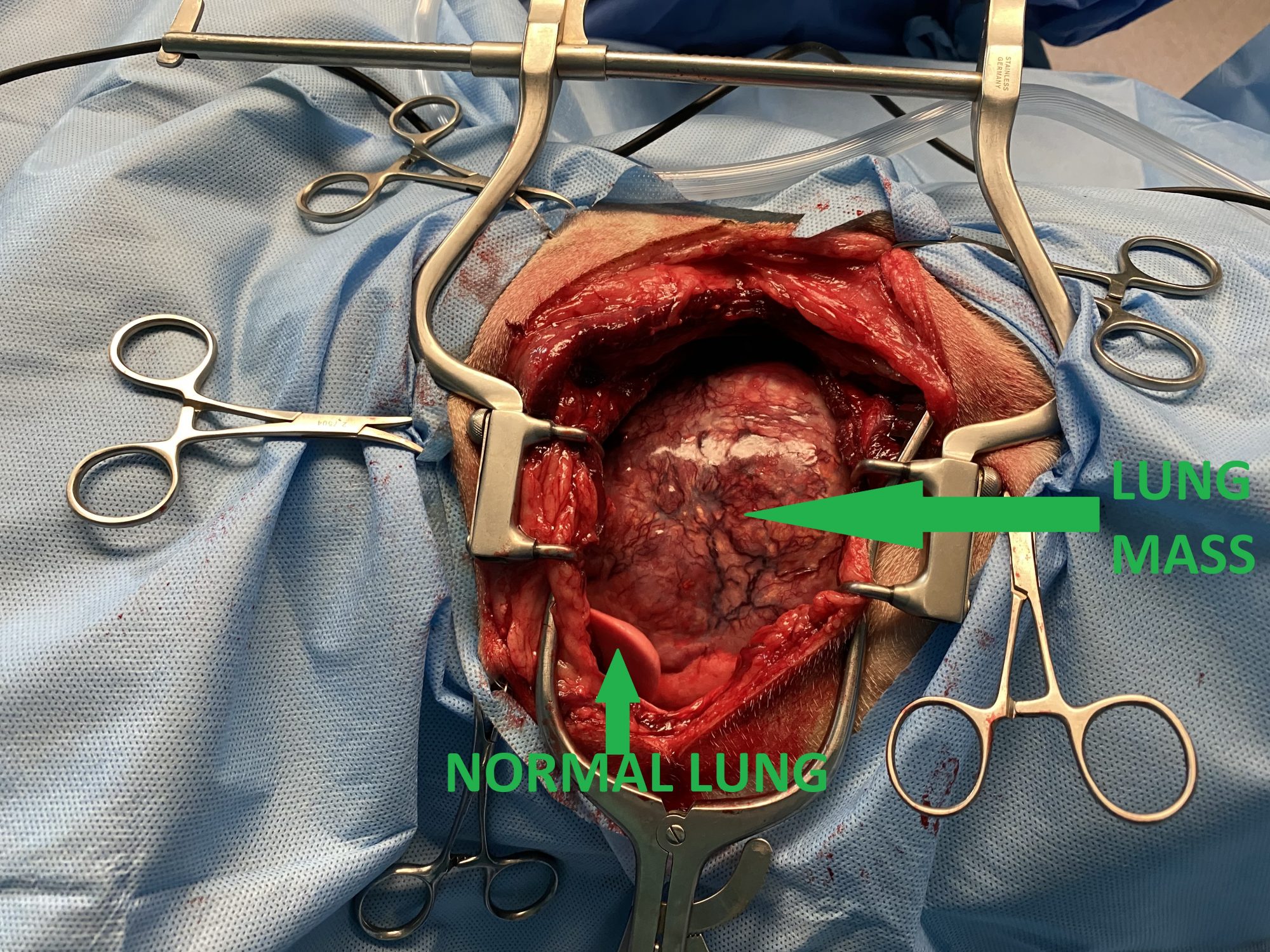
Nino’s owner and I had made a deal before surgery. If anything was different from what we thought, or if the risk was higher than expected, I would call him to brainstorm.
Of course, I kept my promise. We talked in the middle of the open-chest surgery to discuss my findings. I said I was 90% sure I could remove the mass safely. The owner was committed to doing what was best for Nino, so he gave the OK to continue on with surgery.
We went back to surgery. I will spare my sensitive readers of the details of the surgery, obviously it was somewhat delicate…
Meanwhile, the emotional roller coaster goes on: “Once we got your call that we could have a successful outcome with a 90% “belief,” we were extremely excited. A huge weight felt like it was lifted, even though the hard work hadn’t started yet. We continued to do nothing but pray and try to be positive through what will always be one the worst times of our lives yet.”
In order to remove the entire mass, it appeared that we would have to sacrifice the entire left lung, not just the one lobe as planned (removing a whole lung is called a pneumonectomy). In the end, the tumor was removed – safely. Pfew! Mission accomplished.
(Quick crash course in anatomy if this makes no sense. We have 2 lungs, left and right. Each one is made of several parts or “lung lobes”. So instead of removing just the lobe with the mass, we removed all lobes on the left, i.e. the entire left lung. The right lung of course stayed in place.)
FINAL WARNING: THE NEXT PICTURE IS VERY GRAPHIC !!!
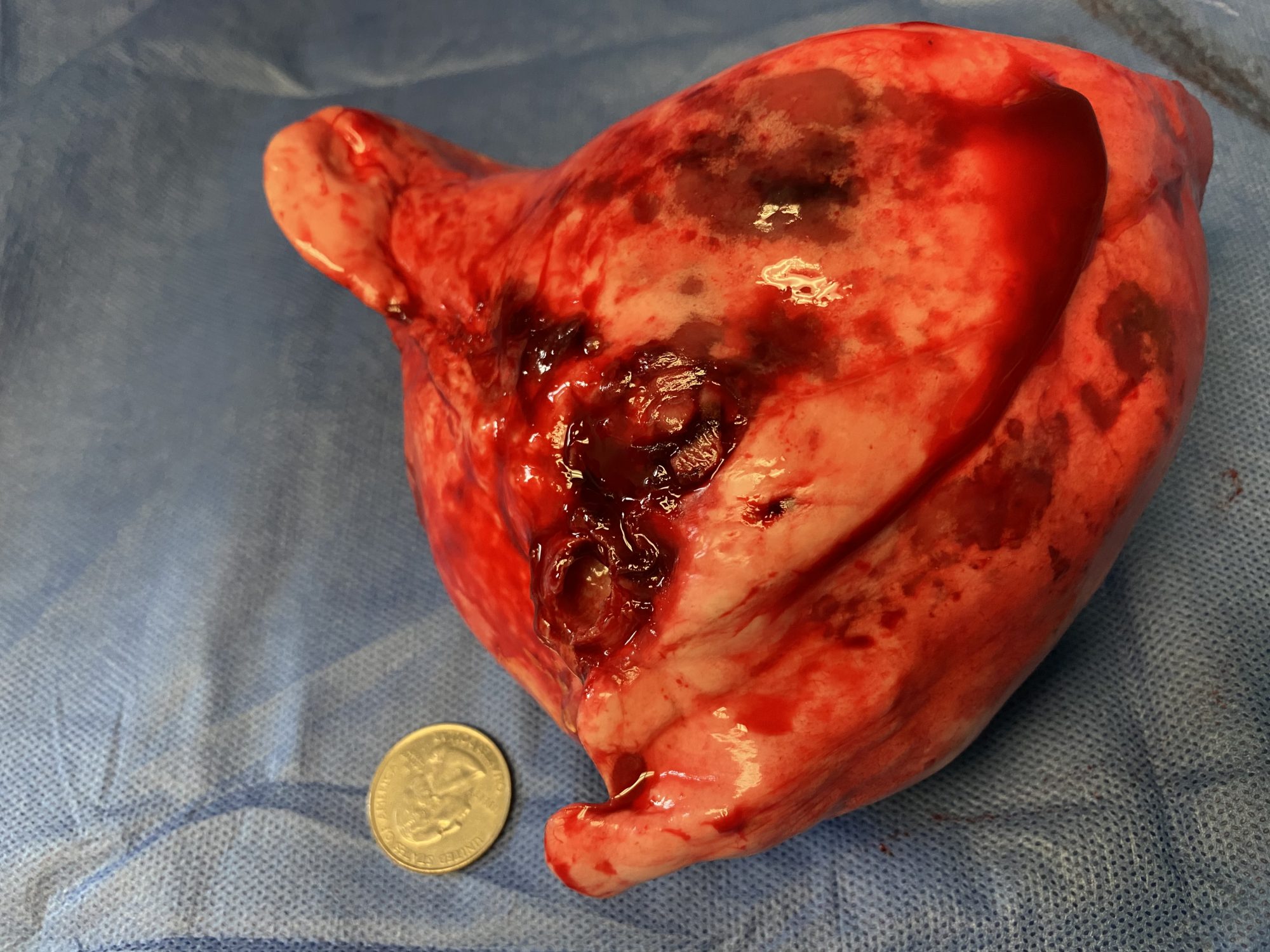
Once the left lung was removed, we needed a way to remove air and fluid from that side of the chest. This is done with a device called a chest tube. It usually only stays in place for a few days after surgery, and can be removed once there is no more air and not too much fluid left.
Nino recovered from surgery and anesthesia smoothly.
That’s when I called the owner again to confirm that surgery was over and Nino was safe – for now.
He later commented: “The news that the mass was removed and he was in recovery was simply a miracle. Nothing else compares to that feeling. Never been more thankful in my life.”
Nino was transferred to the local emergency clinic for overnight care, so the nurses could monitor Nino’s comfort and breathing, and take care of the chest tube.
Nino did so well overnight, that the chest tube was removed the very next day. He was discharged shortly after that. He recovered uneventfully at home.
The next day, his owner sent this amazing update: “He’s been resting and taking all medications without issue. We’ve had no whining/crying at all, and his appetite is great.”
In addition: “Nino has not coughed once. He hasn’t moved much either, but he used to cough just sitting there. So that’s great!
We love having him back home. Nothing is better. And we were so glad to get him back sooner than expected.
His breathing also seems to be much smoother and normal paced.”
About a week later, the biopsy results came back and confirmed the suspicion of lung cancer (pulmonary carcinoma).
Two weeks after surgery, another great update: “Nino is still doing great. He is eating, drinking and relieving himself regularly with no issue. (…)
He has more energy and strength than expected, so our biggest battle lately is keeping him from running or playing.
His breathing seems to be slower and more controlled than it was before his surgery and he seems more comfortable in general. We have had a couple random coughs but nothing alarming.”
In case you’re wondering: dogs, like people, can live with only one lung. Nino may not be able to run a marathon, but this amazing 11 year old trooper should be able to live a happy, comfortable life as a family pet.
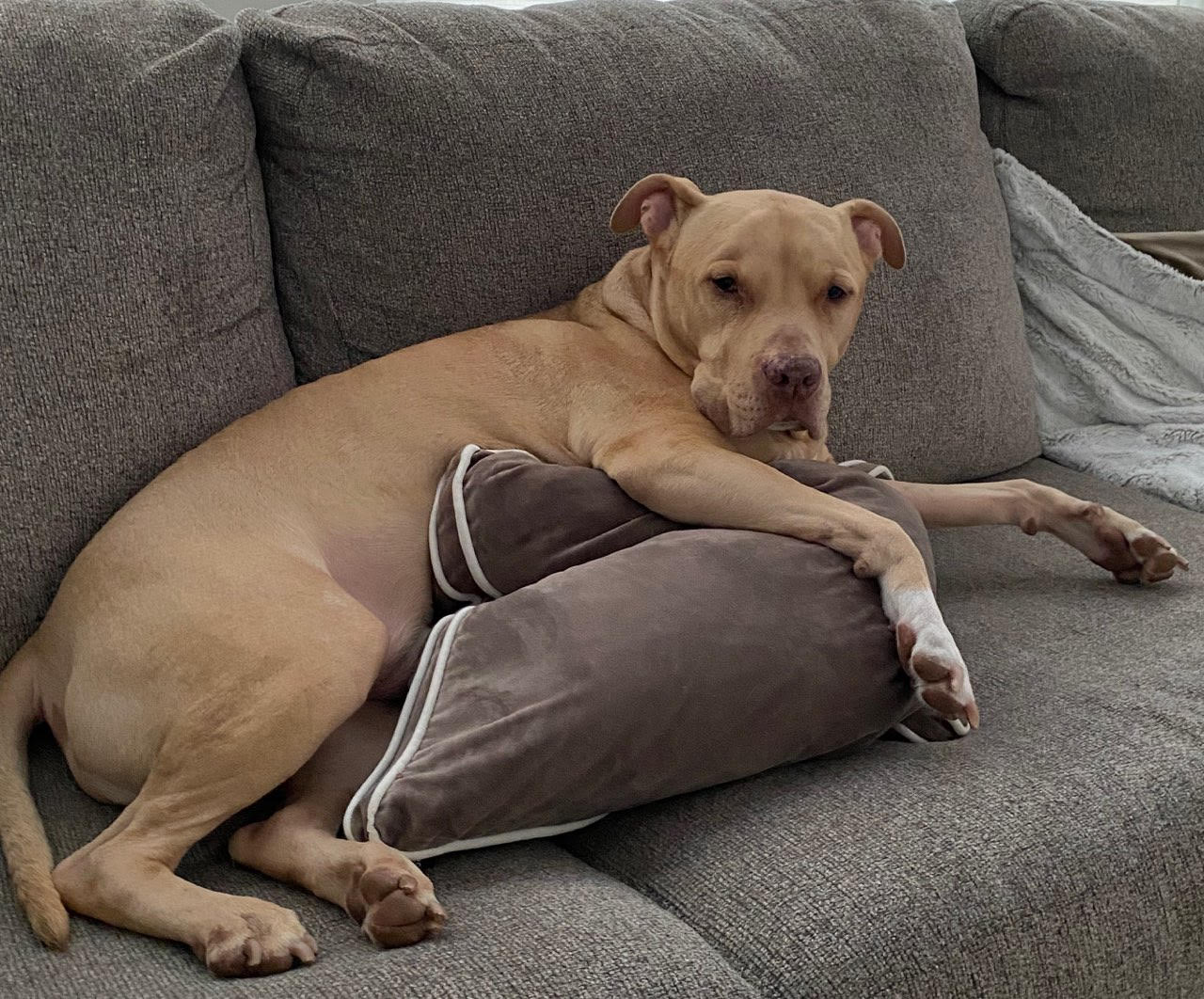
As of this writing, it’s been over 2 months since surgery and the patient is doing well.
Nino’s super dedicated owner concludes: “Thanks to you and your team, we have a second shot at life. This has been a nightmare since our first visit with our vet. I had never been so scared of something and so scared of trusting anyone. You and your team saved our dog’s life. There has been no greater moment in our lives.”
Phil Zeltzman, DVM, DACVS, CVJ, Fear Free Certified

Dr. Phil Zeltzman is a traveling veterinary surgeon in Pennsylvania & New Jersey. An award-winning author, he loves to share his adventures in practice along with information about vet medicine and surgery that can really help your pets. Dr. Zeltzman specializes in orthopedic, neurologic, cancer, and soft tissue surgeries for dogs, cats, and small exotics. By working with local family vets, he offers the best surgical care, safest anesthesia, and utmost pain management to all his patients. Sign up to get an email when he updates his blog, and follow him on Facebook, too!
Even dinosaurs got cancer!
We regularly talk about cancer in this blog.
And we’ve talked about one aggressive type that can affect dogs (and people) (and rarely cats): bone cancer, aka osteosarcoma.
For the first time ever, scientists just discovered that even dinosaurs got cancer!
The dinosaur in question is a Centrosaurus.
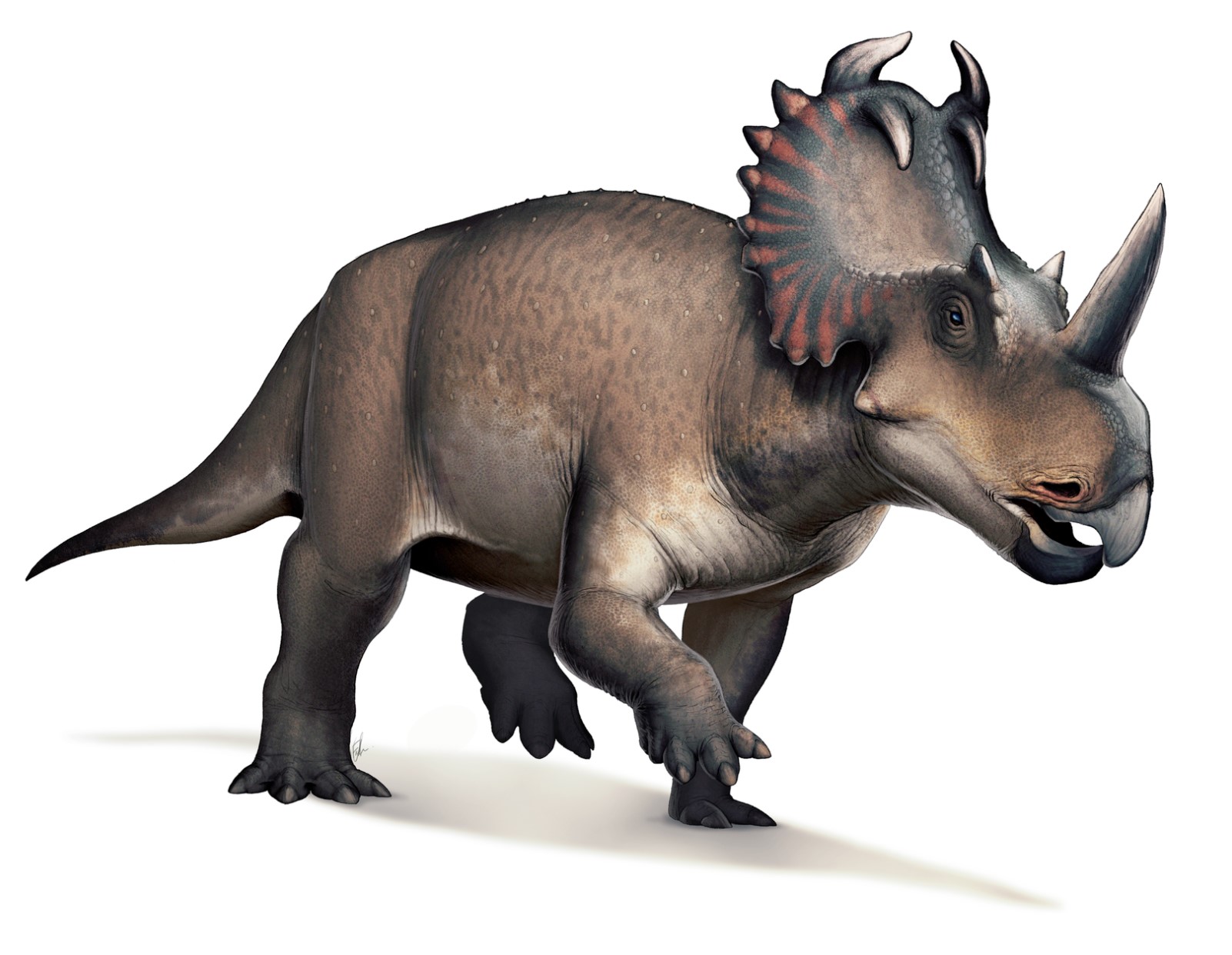
Centrosaurus was a lovely plant-eating “horned dinosaur” that stood 18 foot tall (almost 6 meters) around 76 million years ago.
Scientists from the Royal Tyrrell Museum of Paleontology (Alberta, Canada) discovered the bone with cancer in a pile of bones in Dinosaur Provincial Park in Alberta. The dinosaurs may have died in a flash flood.
The bone in question is a fibula, the small bone along the tibia or shin bone (and the sharp bone in a chicken leg or drumstick). The scientists confirmed the type of cancer via CT scans and under the microscope. The findings were published in the medical journal The Lancet.
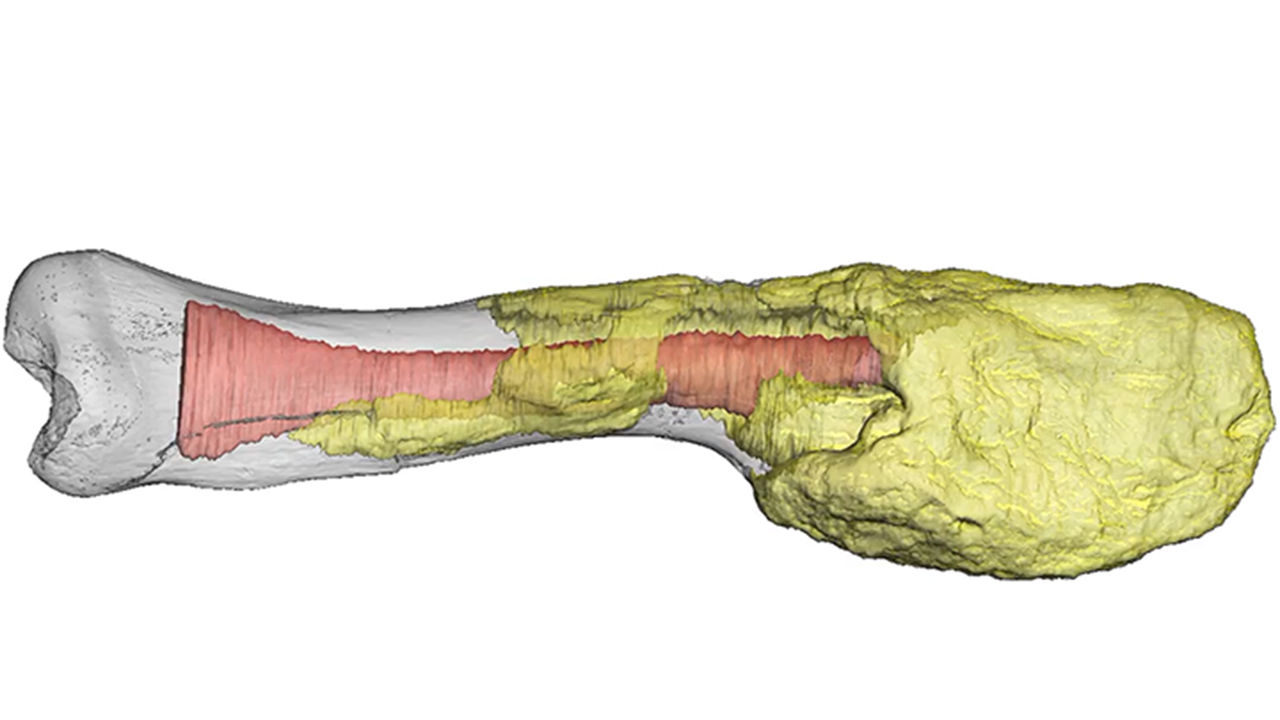
Why should we care? It’s very interesting from an evolution standpoint. It means that cancer existed when dinosaurs lived, well before mammals and reptiles became two different animals.
Royal Ontario Museum paleontologist David Evans told Smithsonian writer Riley Black: “Dinosaurs can seem like mythical creatures, but they were living, breathing animals that suffered through horrible injuries and diseases. This discovery certainly makes them more real and helps bring them to life.”
Phil Zeltzman, DVM, DACVS, CVJ, Fear Free Certified

Dr. Phil Zeltzman is a traveling veterinary surgeon in Pennsylvania & New Jersey. An award-winning author, he loves to share his adventures in practice along with information about vet medicine and surgery that can really help your pets. Dr. Zeltzman specializes in orthopedic, neurologic, cancer, and soft tissue surgeries for dogs, cats, and small exotics. By working with local family vets, he offers the best surgical care, safest anesthesia, and utmost pain management to all his patients. Sign up to get an email when he updates his blog, and follow him on Facebook, too!
Top 10 Reasons To Neuter Your Pet
Clearly today’s topic is sensitive and it will ruffle some feathers… but please hold the hate mail.

It never ceases to amaze me the number of cats and dogs who end up on my surgery table because they were not neutered. Many end up hit by a car. Many end up with a specific type of hernia (more below).
Then there are all the non-surgical reasons, starting with behavior problems.
Are you wondering whether you should neuter your cat or your dog? Here is a non-exhaustive list of 10 reasons to do it.
1. Unwanted pregnancies
Ah… Love at first sight… It’s really difficult for an intact male to resist a female in heat! An intact male classically runs away and can follow the smell of a pretty female in heat located miles away. And keep in mind that one single incident can lead to 4, 8 or 10 puppies or kittens!
Incidentally, you may be liable if your male procreates with somebody’s prized female. Suddenly, the miracle of life has a bittersweet taste, doesn’t it?
2. Pet overpopulation
Meanwhile, 3 to 4 million of unwanted pets are euthanized each year. What a tragedy… This is called “pet overpopulation”.
Many of these deaths could have been avoided by neutering males (and spaying females).
So sterilizing your pet ultimately makes the world a better place.
3. Behavior
Unneutered pets have all kinds of behavioral problems. In male dogs, the most common behavior is an aggressive temper. Of course, there are many intact pets who are perfectly sweet. Neutering, when done early in life, can reduce aggressiveness and improve behavior overall. For example, it decreases the always-awkward “mounting” behavior in dogs.
4. Marking
Few things smell worse than intact male cat urine. Some people make their indoor cat an outdoor cat when they can’t tolerate the smell anymore. This increases the risk of being hit by a car or getting into a fight. Neutering, when done early enough in life, virtually eliminates the odor of male cat urine and should prevent marking in male dogs.
5. Roaming and getting in trouble
Pets are rarely taught how to cross the street safely. So when they roam, searching for trouble or looking for a partner, they might get hit by a car.
In fact, many pets I treat for a fracture are intact. Neutering reduces the urge to roam or run away from home.
In addition, neutering decreases the risk of getting into a fight, especially in tom cats. They commonly get nasty abscesses from these fights.
Family and emergency vets regularly see wounds from dog bites, and I assure you that it’s rarely pretty. I’ve seen many dogs die after getting attacked by another dog.

6. Roaming and getting lost
Every year, millions of pets get lost. Some are returned to their owner. Most are not. To decrease the risk of such a tragedy happening in your family, neuter your pet, pet-proof the fence in your backyard and always keep your pet on a leash during walks.
In addition, talk to your vet about the benefits of tattoos and microchips.
7. Prostate disease
Intact male dogs can have a number of diseases of the prostate including cysts, abscesses and enlargement. The latter is called “benign prostatic hyperplasia,” just as in older men. Neutering (of dogs!) prevents these problems.
8. Perineal hernia
A perineal hernia is a fixable but annoying problem mostly seen in intact male dogs. Organs from the belly can slip or herniate through weakened muscles in the pelvis. The consequence is a bulge on one or both sides of the anus. The hernia can contain fat, fluid or even the bladder. These hernias frequently cause constipation.
This condition is believed to be due to testosterone (from the testicles). Neutering dramatically reduces the risk of these hernias.
9. Testicular tumors
Neutering eliminates the risk of testicular cancer. This condition, mostly seen in intact male dogs, is believed to be due to testosterone (from the testicles). It’s simple, really: no testicles, no testicular cancer.
One more reason to neuter is when a male is cryptorchid, i.e. when a testicle does not come down and remains in the belly. The testicle left in the belly has a much higher risk of becoming cancerous. So this may require 2 surgeries: 1 to remove the “outside” testicle, and 1 in the belly to find and remove the other one. Occasionally, both testicles are in the abdomen.
10. Genetics
Yet another reason to neuter is to prevent spreading bad genes. Pets with hip dysplasia, eye diseases, heart conditions and many other genetic conditions should not be allowed to breed.
It seems, however, that neutering does not decrease, and in fact may increase, the risk of prostate cancer. Luckily, this is a very rare tumor. Therefore, the combined benefits of neutering vastly outweigh the risk of prostate cancer as you can see from this top 10 list.
The next controversy is when to neuter your pet. Again, hold the hate mail: most reasonable vets recommend neutering at 6 months of age.
Phil Zeltzman, DVM, DACVS, CVJ, Fear Free Certified

Dr. Phil Zeltzman is a traveling veterinary surgeon in Pennsylvania & New Jersey. An award-winning author, he loves to share his adventures in practice along with information about vet medicine and surgery that can really help your pets. Dr. Zeltzman specializes in orthopedic, neurologic, cancer, and soft tissue surgeries for dogs, cats, and small exotics. By working with local family vets, he offers the best surgical care, safest anesthesia, and utmost pain management to all his patients. Sign up to get an email when he updates his blog, and follow him on Facebook, too!
Is my pet’s surgery urgent?

As you can imagine, some conditions are more severe and urgent than others.
Removing a small lump that’s been there for 3 months is logically less urgent than a C-section.
Still, how do you, how does your family vet, how does a surgeon, decide what surgery is urgent and what is not?
A simple way to decide is to consider that a surgery is urgent if not performing it would cause irreversible harm. This can include:
. Threat to the patient’s life (e.g. severe internal bleeding, “bloat” or a “twisted stomach”, pyometra aka an infected uterus, some C-sections)
. Risk of irreversible damage to the patient’s physical health (e.g. difficulty breathing, risk of paralysis of the legs)
. Threat of permanent harm of an extremity or an organ (e.g. urinary blockage that can cause kidney damage, intestinal blockage that can damage the intestine)
. Risk of rapid worsening of severe symptoms (e.g. a pet hit by a car with open wounds).
. Severe pain that can be solved with surgery (e.g. a severely broken bone that cannot be stabilized)
On the opposite, some surgeries are not urgent: most lumps and bumps, a torn ACL, some fractures that can be stabilized (e.g. with a splint), bladder stones, etc.
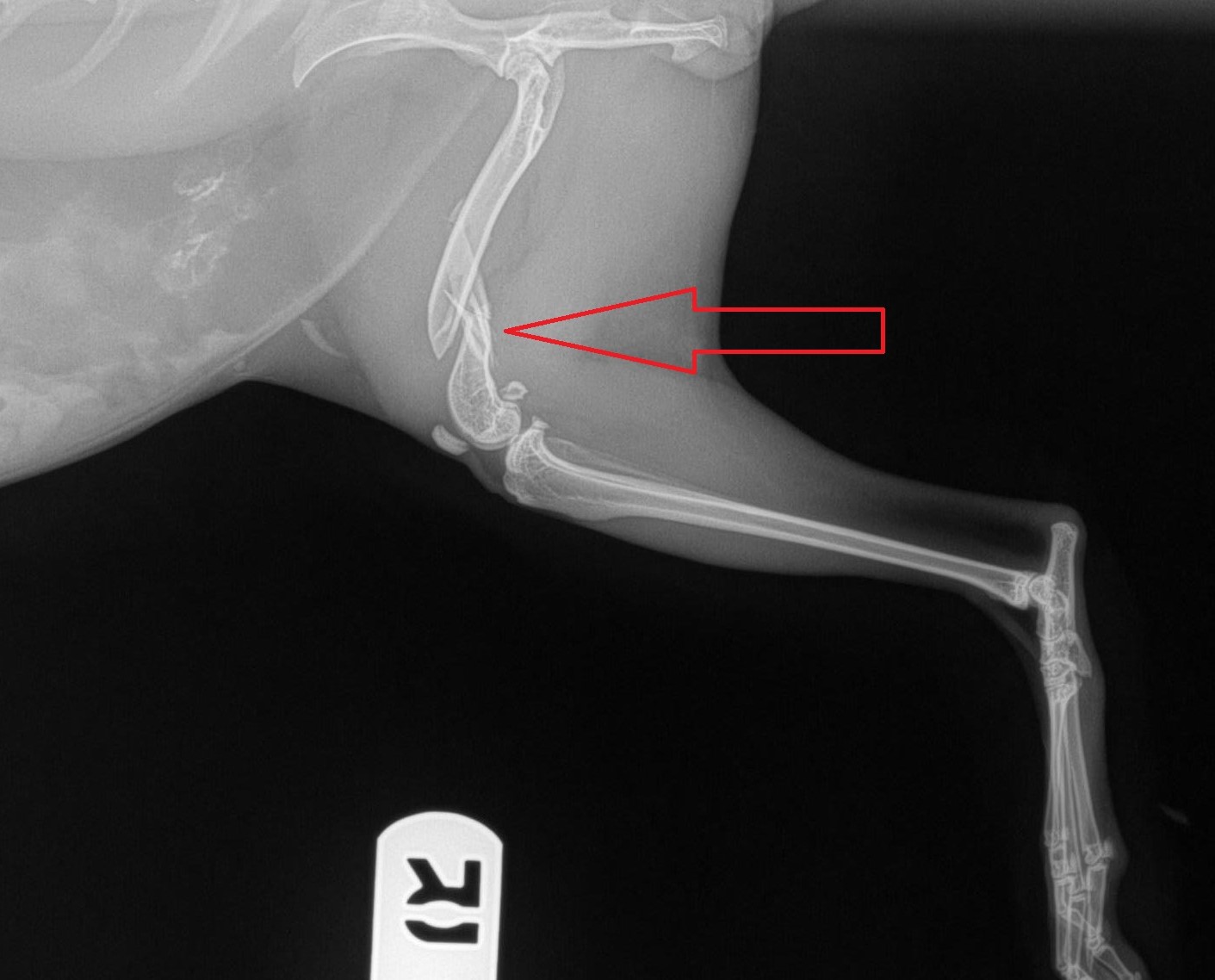
Now, just because these surgeries are not considered urgent, doesn’t mean that you should procrastinate for months!
. Delaying the removal of bladder stones can lead to a blockage (of the urethra) that can in turn cause kidney damage and heart problems.
. Removing a small tumor is obviously less invasive than removing a huge one.
. Delaying the repair of a torn ACL for months means that there will be much more arthritis and muscle loss (and pain).
Even though some of the above examples are sometimes debatable, these are pretty good guidelines.
Everything is relative, even in the surgery world…
Basically, urgent or emergency surgery is recommended when it provides relief to the patient or to an organ, and a non-surgery option is not available or practical.
Importantly, as you read these examples, please remember that I am only talking about surgical conditions. There are countless other conditions that are medical, i.e. that are not treated with surgery. Those are beyond the scope of this blog.
Bottom line: when in doubt about a specific condition in your pet, the best thing you can do is ask your family vet, an emergency vet, or ideally, a surgeon.
Phil Zeltzman, DVM, DACVS, CVJ, Fear Free Certified

Dr. Phil Zeltzman is a traveling veterinary surgeon in Pennsylvania & New Jersey. An award-winning author, he loves to share his adventures in practice along with information about vet medicine and surgery that can really help your pets. Dr. Zeltzman specializes in orthopedic, neurologic, cancer, and soft tissue surgeries for dogs, cats, and small exotics. By working with local family vets, he offers the best surgical care, safest anesthesia, and utmost pain management to all his patients. Sign up to get an email when he updates his blog, and follow him on Facebook, too!

